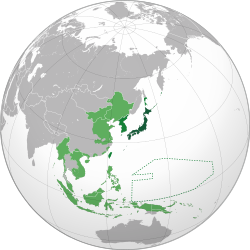Empire o Japan
| Empire o Japan | |
| Offeecial Term name | |
|---|---|
| Offeecial Term | Empire o Japan |
| Literal Translation name | |
| Literal Translation | Empire o Great Japan |
The Empire o Japan (大日本帝國 Dai Nippon Teikoku, literally "Empire o Great Japan") wis an empire an warld pouer that existit frae the Meiji Restoration on 3 Januar 1868 tae the enactment o the post-Warld War II Constitution o Japan on 3 Mey 1947.[3]
Imperial Japan's rapid industrialization an militarization unner the slogan Fukoku Kyōhei (富国強兵, "Enrich the Kintra, Strengthen the Airmy") led tae its emergence as a warld pouer, eventually culminatin in its membership in the Axis alliance an the conquest o a muckle pairt o the Asie-Paceefic region. At the hicht o its pouer in 1942, the Japanese Empire ruled ower a land aurie spannin 7,400,000 square kilometre (2,857,000 sq mi), makin it ane o the lairgest maritime empires in history.[5]
Efter several muckle-scale militar successes durin the Seicont Sino-Japanese War (1937–1945) an the Paceefic War, the Empire o Japan an aa gained notoriety for its war crimes against the fowks o the kintras it conquered. Efter sufferin mony defeats an the atomic bombins o Hiroshima an Nagasaki, houiver, the Empire o Japan surrendered tae the Allies on 2 September 1945. A period o occupation bi the Allies follaeed the surrender, an a new constitution wis creatit wi American involvement. The constitution came intae force on 3 Mey 1947, offeecially dissolvin the Empire. American occupation an Japanese reconstruction o the kintra continued well intae the 1950s, eventually furmin the current naition-state whose full title is the "State o Japan" (Nippon-koku) simply rendered "Japan" in Inglis.
The Emperors durin this time, which spanned the entire Meiji an Taishō, an the lesser pairt o the Shōwa eras, are nou kent in Japan bi thair posthumous names, which coincide wi those era names: Emperor Meiji (Mutsuhito), Emperor Taishō (Yoshihito), an Emperor Shōwa (Hirohito).
References
[eedit | eedit soorce]- ↑
- Sarah Thal. "A Religion That Was Not a Religion: The Creation of Modern Shinto in Nineteenth-Century Japan". In The Invention of Religion., eds. Peterson and Walhof (New Brunswick, NJ: Rutgers University Press, 2002). pp. 100-114
- Hitoshi Nitta. "Shintō as a ‘Non-Religion’: The Origins and Development of an Idea". In Shintō in History: Ways of the Kami, eds. Breen and Teeuwen (Honolulu: University of Hawai’i, 2000).
- John Breen, “Ideologues, Bureaucrats and Priests”, in Shintō in History: Ways of the Kami.
- Hitoshi Nitta. The Illusion of "Arahitogami" "Kokkashintou". Tokyo: PHP Kenkyūjo, 2003.
- ↑ The existence of a religion was determined ex post facto by the Supreme Commander for the Allied Powers. See Shinto Directive.
- ↑ a b c "Chronological table 5 1 December 1946 - 23 June 1947". National Diet Library. Retrieved 30 September 2010.
- ↑ One can date the "restoration" of imperial rule from the edict of 3 January 1868. Jansen, p.334.
- ↑ Bruce R. Gordon (2005). To Rule the Earth... (See Bibliography for sources used.)
Freemit airtins
[eedit | eedit soorce] Media relatit tae Empire of Japan at Wikimedia Commons
Media relatit tae Empire of Japan at Wikimedia Commons



